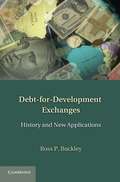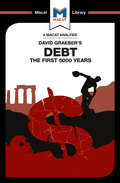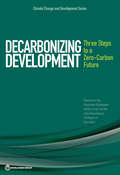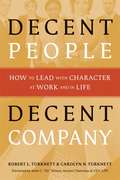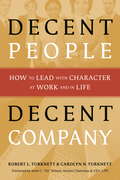- Table View
- List View
Debt-Related Vulnerabilities and Financial Crises (EPub)
by Brad Setser Alexander Pitt Christoph B. Rosenberg Christian Keller Jens Nystedt Brett E. House Ioannis HalikiasThe analysis of currency and maturity mismatches in sectoral balance sheets has increasingly become a regular element in the IMF's tool kit for surveillance in emerging market countries. This paper describes this so-called balance sheet approach and shows how it can be applied to detect vulnerabilities and shape policy advice. It also provides a broad-brushed overview of how balance sheet vulnerabilities have evolved over the past decade and cites a number of case studies.
Debt-for-Development Exchanges
by Ross P. BuckleyDebt-for-development exchanges are an important financing tool for development. They make debt relief more politically and practically attractive to donor countries and serve the development of recipient countries through the cancellation of external debt and the funding of important development projects. This book commences by chronicling the emergence of debt-for-development exchanges from their forebears, debt-equity exchanges, and analyzes why debt for development suffers from very few of the problems that plagued debt equity. The book analyzes the different types of debt-for-development exchanges and the different ways they have been used by all donor nations that have made use of them. The book then explores a range of critical perspectives on exchanges and concludes by considering a wide range of new and innovative uses for the funds generated by exchanges.
Debt-free U: How I Paid for an Outstanding College Education without Loans, Scholarships, or Mooching Off My Parents
by Zac BissonnetteThis book can save you more than $100,000. These days, most people assume you need to pay a boatload of money for a quality college education. As a result, students and their parents are willing to go into years of debt and potentially sabotage their entire financial futures just to get a fancy name on their diploma. But Zac Bissonnette is walking proof that this assumption is not only false, but dangerous--a class con game designed to rip you off and doom your student to a post-graduation life of near poverty. From his unique double perspective--he's a personal finance expert (at Daily Finance) AND a current senior at the University of Massachusetts-- Zac figured out how to get an outstanding education at a public college, without bankrupting his parents or taking on massive loans. Armed with his personal knowledge, the latest data, and smart analysis, Zac takes on the sacred cows of the higher education establishment. He reveals why a lot of the conventional wisdom about choosing and financing college is not only wrong but hazardous to you and your child's financial future. You'll discover, for instance, that: * Student loans are NOT a necessary evil. Ordinary middle class families can- and must-find ways to avoid them, even without scholarships. * College "rankings" are useless-designed to sell magazines and generate hype. If you trust one of the major guides when picking a college, you face a potential financial disaster. * The elite graduate programs accept lots of people with non-elite bachelors degrees. So do America's most selective employers. The name on a diploma ultimately won't help your child have a more successful career or earn more money. Zac can prove every one of those bold assertions - and more. No matter what your current financial situation, he has a simple message for parents: "RELAX! Your kid will be able to get a champagne education on a beer budget!"
Debt: Ethics, the Environment, and the Economy
by Peter Y. Paik Merry Wiesner-HanksFrom personal finance and consumer spending to ballooning national expenditures on warfare and social welfare, debt is fundamental to the dynamics of global capitalism. The contributors to this volume explore the concept of indebtedness in its various senses and from a wide range of perspectives. They observe that many views of ethics, citizenship, and governance are based on a conception of debts owed by one individual to others; that artistic and literary creativity involves the artist's dialogue with the works of the past; and that the specter of catastrophic climate change has underscored the debt those living in the present owe to future generations.
Debt: The First 5,000 Years
by David GraeberEvery economics textbook says the same thing: Money was invented to replace onerous and complicated barter systems-to relieve ancient people from having to haul their goods to market. The problem with this version of history? There's not a shred of evidence to support it. Here anthropologist David Graeber presents a stunning reversal of conventional wisdom. He shows that for more than 5,000 years, since the beginnings of the first agrarian empires, humans have used elaborate credit systems to buy and sell goods-that is, long before the invention of coins or cash. It is in this era, Graeber argues, that we also first encounter a society divided into debtors and creditors. Graeber shows that arguments about debt and debt forgiveness have been at the center of political debates from Italy to China, as well as sparking innumerable insurrections. He also brilliantly demonstrates that the language of the ancient works of law and religion (words like "guilt," "sin," and "redemption") derive in large part from ancient debates about debt, and shape even our most basic ideas of right and wrong. We are still fighting these battles today without knowing it. Debt: The First 5,000 Years is a fascinating chronicle of this little known history-as well as how it has defined human history, and what it means for the credit crisis of the present day and the future of our economy.
Debt: The First 5000 Years
by Sulaiman HakemyDebt is one of the great subjects of our day, and understanding the way that it not only fuels economic growth, but can also be used as a means of generating profit and exerting control, is central to grasping the way in which our society really works. David Graeber's contribution to this debate is to apply his anthropologists' training to the understanding of a phenomenon often considered purely from an economic point of view. In this respect, the book can be considered a fine example of the critical thinking skill of problem-solving. Graeber's main aim is to undermine the dominant narrative, which sees debt as the natural – and broadly healthy – outcome of the development of a modern economic system. He marshals evidence that supports alternative possibilities, and suggests that the phenomenon of debt emerged not as a result of the introduction of money, but at precisely the same time. This in turn allows Graeber to argue against the prevailing notion that economy and state are fundamentally separate entities. Rather, he says, "the two were born together and have always been intertwined" – with debt being a means of enforcing elite and state power. For Graeber, this evaluation of the evidence points to a strong potential solution: there should be more readiness to write off debt, and more public involvement in the debate over debt and its moral implications.
Debtor Nation: The History of America in Red Ink (Politics and Society in Modern America #87)
by Louis HymanThe story of personal debt in modern AmericaBefore the twentieth century, personal debt resided on the fringes of the American economy, the province of small-time criminals and struggling merchants. By the end of the century, however, the most profitable corporations and banks in the country lent money to millions of American debtors. How did this happen? The first book to follow the history of personal debt in modern America, Debtor Nation traces the evolution of debt over the course of the twentieth century, following its transformation from fringe to mainstream—thanks to federal policy, financial innovation, and retail competition.How did banks begin making personal loans to consumers during the Great Depression? Why did the government invent mortgage-backed securities? Why was all consumer credit, not just mortgages, tax deductible until 1986? Who invented the credit card? Examining the intersection of government and business in everyday life, Louis Hyman takes the reader behind the scenes of the institutions that made modern lending possible: the halls of Congress, the boardrooms of multinationals, and the back rooms of loan sharks. America's newfound indebtedness resulted not from a culture in decline, but from changes in the larger structure of American capitalism that were created, in part, by the choices of the powerful—choices that made lending money to facilitate consumption more profitable than lending to invest in expanded production.From the origins of car financing to the creation of subprime lending, Debtor Nation presents a nuanced history of consumer credit practices in the United States and shows how little loans became big business.
Debtors to their Profession: A History of the Institute of Bankers 1879-1979 (Routledge Library Editions: Banking & Finance)
by Edwin GreenThis volume examines the first hundred years of the Institute of Banking’s development within the banking business as a whole, with a particular emphasis upon changes in the staffing requirements of the banks and the importance of professional qualifications in the careers of their employees. The survey includes a description of early attempts to form a professional institute for bankers between the 1840s and the 1870s. By examining the objectives, growth of membership and the extension of the Institute’s activities, this volume throws light upon the changing work and qualifications of bank personnel and offers a case study in the development of a large and important professional group.
Debtors' Prison
by Robert KuttnerOne of our foremost economic thinkers challenges a cherished tenet of today's financial orthodoxy: that spending less, refusing to forgive debt, and shrinking government--"austerity"--is the solution to a persisting economic crisis like ours or Europe's, now in its fifth year. Since the collapse of September 2008, the conversation about economic recovery has centered on the question of debt: whether we have too much of it, whose debt to forgive, and how to cut the deficit. These questions dominated the sound bites of the 2012 U.S. presidential election, the fiscal-cliff debates, and the perverse policies of the European Union. Robert Kuttner makes the most powerful argument to date that these are the wrong questions and that austerity is the wrong answer. Blending economics with historical contrasts of effective debt relief and punitive debt enforcement, he makes clear that universal belt-tightening, as a prescription for recession, defies economic logic. And while the public debt gets most of the attention, it is private debts that crashed the economy and are sandbagging the recovery--mortgages, student loans, consumer borrowing to make up for lagging wages, speculative shortfalls incurred by banks. As Kuttner observes, corporations get to use bankruptcy to walk away from debts. Homeowners and small nations don't. Thus, we need more public borrowing and investment to revive a depressed economy, and more forgiveness and reform of the overhang of past debts. In making his case, Kuttner uncovers the double standards in the politics of debt, from Robinson Crusoe author Daniel Defoe's campaign for debt forgiveness in the seventeenth century to the two world wars and Bretton Woods. Just as debtors' prisons once prevented individuals from surmounting their debts and resuming productive life, austerity measures shackle, rather than restore, economic growth--as the weight of past debt crushes the economy's future potential. Above all, Kuttner shows how austerity serves only the interest of creditors--the very bankers and financial elites whose actions precipitated the collapse. Lucid, authoritative, provocative--a book that will shape the economic conversation and the search for new solutions. From the Hardcover edition.
Debugging Teams: Better Productivity through Collaboration
by Ben Collins-Sussman Brian W. FitzpatrickIn the course of their 20+-year engineering careers, authors Brian Fitzpatrick and Ben Collins-Sussman have picked up a treasure trove of wisdom and anecdotes about how successful teams work together. Their conclusion? Even among people who have spent decades learning the technical side of their jobs, most haven’t really focused on the human component. Learning to collaborate is just as important to success. If you invest in the "soft skills" of your job, you can have a much greater impact for the same amount of effort. The authors share their insights on how to lead a team effectively, navigate an organization, and build a healthy relationship with the users of your software. This is valuable information from two respected software engineers whose popular series of talks—including "Working with Poisonous People"—has attracted hundreds of thousands of followers.
Debunkery
by Kenneth L. Fisher Lara HoffmansLegendary money manager Ken Fisher outlines the most common--and costly--mistakes investors make.Small cap stocks are best for all time. Bunk!A trade deficit is bad for markets. Bunk!Stocks can't rise on high unemployment. Bunk!Many investors think they are safest following widely accepted Wall Street wisdom--but much of Wall Street wisdom isn't so wise. In fact, it can be costly bunk.In Debunkery: Learn It, Do It, and Profit From It--Seeing Through Wall Street's Money-Killing Myths, Ken Fisher--named one of the 30 most influential individuals of the last three decades by Investment Advisor magazine--details why so many investors fail to get the long-term results they desire. The short answer is many investors fail to question if what they believe is true--and are therefore blinded by tradition, biases, ideology, or any number of cognitive errors.Your goal as an investor shouldn't be to be error-free--that's impossible. Rather, to be more successful, you should aim to lower your error rate. Debunkery gets you started by debunking 50 common myths--but that's just the beginning. It also gives you the tools you need to continue to do your own debunkery for the rest of your investing career.
Decadence and Objectivity: Ideals for Work in the Post-consumer Society
by Lawrence HaworthHaworth's concerns are urgent. Modern society, he argues, threatens to collapse under the burden of mindless growth. Its demands have begun to exhaust the world's resources. The pursuit of growth has hollowed out our social foundations. Advanced technology has emancipated us from toil but condemned us to work that is perceived as meaningless. The dissolution of traditional communities has resulted in a society which has no sense of common concern or public purpose. Most people live largely in private spheres, and value the public sphere only for its capacity to improve their private lives, a function which is exercised unevenly and is largely incidental to its purpose. Modern urban society is characterized by its 'decadence,' a pervasive lack of inspiring vision. In this book Haworth concerns himself with the conceptual foundations of social order and the options for a future society. He analyses two sharply contrasting systems, the one committed to individual satisfaction and independence and the other based on collective values and rewards. Both would retain advanced technology but restrain consumption. The leisure-oriented society would reduce the hours of work at a sacrifice of efficiency and at the expense of individual determination. This analysis provides the basis for a new model of what Haworth calls an 'objective' society, based on the ideals of responsibility, leisureliness, and professionalism. These ideals imply a sympathetic yet not strictly custodial attitude towards the natural world, a responsible use of human creativity and natural potential, a sense of absorption in the present (in the original Greek sense of leisure which is contrasted with the more recent association of leisure with discretionary time), and above all a sense of professional commitment. Commitment links individuals who locate the point of their lives outside themselves and their private interests in some work for which they have a distinctive talent and in the pursuit of which they experience a meaningful, shared existence. Lawrence Howarth offers a model, not a blueprint, but it is one that political scientists, economists, sociologists, urban planners, and all who are committed to improving the design of our society should consider carefully.
Decarbonisation Pathways for African Cities (Palgrave Studies in Climate Resilient Societies)
by Smith I Azubuike Ayodele Asekomeh Obindah GershonThis book examines the pathways to decarbonising African cities, structured around strategies and applications in renewable energy, waste management, healthcare, telecommunication, education and governance reconfigurations for Petro-cities. Throughout the book the authors highlight infrastructural, governance and policy approaches to drive decarbonisation. Opening with chapters focused on propositions for solar urban planning and scope for decarbonisation in waste management the book then moves on to examine innovative strategies for a low-carbon healthcare sector. The authors then discuss the use of hybrid power systems at remote telecommunication sites, their deployment on university campuses, and how this can be optimised to reduce carbon emissions. Further chapters explore government, private sector and civil society actions for decarbonising Kenyan cities and an overview of the political economic choices for decarbonising Petro-cities. Finally, closing chapters propose mechanisms for translating COP26 takeaways to decarbonisation policies and a low-carbon framework for African cities.
Decarbonisation and Digitization of the Energy System: Proceedings of the 2nd International Conference on Smart Grid Energy Systems and Control, SGESC 2023 (Lecture Notes in Electrical Engineering #1099)
by Ashwani Kumar Pradeep Kumar S. N. SinghThe book contains select proceedings of the International Conference on Smart Grid Energy Systems and Control (SGESC 2023). The proceedings are divided into 02 volumes, and this volume focuses on the Decarbonisation and Digitization of the Energy System. The book covers the important topics on the smart grid/microgrids and control aspects, optimal energy scheduling, distributed generation, wind energy for remote electrification, forecasting of loads and daily energy demand, reactive power management, Volt-Var control, reactive power procurement, and ancillary services, the role of FACTS devices for reactive power management and control, feasibility study of PV/Wind hybrid systems, electricity markets, stability of the power system network, energy storage systems and electrical vehicles. This book is a unique collection of 27 chapters from different areas with a common theme and will be immensely useful to academic researchers and practitioners in the industry.
Decarbonisation: From Industrial to Personal Uses (SpringerBriefs in Applied Sciences and Technology)
by Thierry LucidarmeThis book is an insightful introduction to the pressing issues surrounding the climate emergency. The book proposes a set of principles of action, which prioritize technological solutions classified in descending order of carbon density. The book highlights the urgent need to decarbonize industrial sites, as they are the primary sources of carbon emissions. It presents a rational approach to limiting emissions by improving the operational efficiency of industrial processes, electrification, and substitution of fossil fuels with carbon-free energy vectors such as hydrogen or ammonia. The book also describes processes for carbon capture, sequestration in the subsoil, and recovery through industrial products. To demonstrate the application of these principles in difficult-to-decarbonize industrial segments, the book uses the industrial transport industry as an example. It also addresses the decarbonization of individual uses, such as electric cars for individual transport and heat pumps for individual heating. The book concludes by discussing the capture of carbon directly from the atmosphere. It presents a comprehensive view of decarbonization technology, providing readers with a clear understanding of the technological basis required to develop any decarbonization roadmap. The book takes a scientific and engineering approach, trying to avoid any ideological or apocalyptic stance sometimes associated with the topic. The reader is left with a logical and realistic perspective of decarbonization, taking into account scientific and economic logic and orders of magnitude.
Decarbonization as a Route Towards Sustainable Circularity (SpringerBriefs in Applied Sciences and Technology)
by Maria Magdalena Ramirez-Corredores Mireya R. Goldwasser Eduardo Falabella de Sousa AguiarThis book surveys the current research on CO2 conversion processes and shows that these can close the carbon cycle as part of a circular economy. The technical and economic feasibility of these processes are examined together and current scientific challenges are signposted, which will guide future R&D. Technology sustainability is key for meeting and keeping decarbonization goals in the long term. However, considering economic and environmental sustainability individually is not enough. An integral view of sustainability that incorporates an energy term in the equation is needed. This book brings this concept to the fore.
Decarbonize Public and Commercial Buildings: China Building Energy and Emission Yearbook 2022
by Tao Zhang Xiaohua Liu Yi Jiang Shan Hu Qingpeng WeiOne of the key motivations and goals for China's social and economic development is the dual carbon target. Building is one of the most important sectors to reduce emissions and save energy, accounting for more than 20% of China's primary energy consumption and carbon emissions. This book analyzes the energy consumption of China's buildings sector in four categories, their characteristics and technologies to improve energy efficiency, and examines the greenhouse gas emissions of China's buildings, including building construction embodied emission and building operation emissions. In particular, this book discusses the ways to achieve carbon neutrality targets for China's public and commercial building sectors. This book also analyzes the energy mix, energy intensity, and technological prospects for achieving energy and carbon targets in the public and commercial building sectors. This book contains a large amount of survey data, monitoring data, and case studies. The debate on technologies and policies is underpinned by a variety of evidence and research that has been ongoing for more than a decade. The information, data, and policy recommendations will be of interest to a national and international audience working in the fields of energy, climate change, engineering, and building science.
Decarbonize Urban Heating System: China Building Energy and Emission Yearbook 2023
by Building Energy Research Center of THUThis is an open access book.The double-carbon target has been one of the main motivations and goals for China's social and economic development. The building sector is one of the most important sectors to achieve energy saving and emission reduction. This publication thoroughly examines China's building energy use and carbon emissions with a focus on four categories, including their characteristics and the technologies needed to achieve zero carbon emissions.This year, the key issue is developing carbon-neutrality pathways for China's urban heating system. This report comprehensively discusses the current status and future forecast of heat demand in buildings and non-process industries, introduces the challenges facing the urban energy supply system in achieving carbon neutrality, and elucidates the low-carbon heating model based mainly on low-grade and low-carbon waste heat. Extensive survey and monitoring data and case studies are presented throughout the book. The discussion of technologies and policies has been the subject of extensive research and evidence for over a decade. The information, data, and policy recommendations are of relevance to a national and global audience working in the fields of energy, climate change, engineering, and building science.
Decarbonizing Development
by Marianne Fay Adrien Vogt-Schilb Ulf Narloch Tom Kerr Stephane Hallegatte RozenbergThe science is unequivocal: stabilizing climate change implies bringing net carbon emissions to zero. This must be done by 2100 if we are to keep climate change anywhere near the 2oC warming that world leaders have set as the maximum acceptable limit. Decarbonizing Development: Three Steps to a Zero-Carbon Future looks at what it would take to decarbonize the world economy by 2100 in a way that is compatible with countries' broader development goals. Here is what needs to be done: -Act early with an eye on the end-goal. To best achieve a given reduction in emissions in 2030 depends on whether this is the final target or a step towards zero net emissions. -Go beyond prices with a policy package that triggers changes in investment patterns, technologies and behaviors. Carbon pricing is necessary for an efficient transition toward decarbonization. It is an efficient way to raise revenue, which can be used to support poverty reduction or reduce other taxes. Policymakers need to adopt measures that trigger the required changes in investment patterns, behaviors, and technologies - and if carbon pricing is temporarily impossible, use these measures as a substitute. -Mind the political economy and smooth the transition for those who stand to be most affected. Reforms live or die based on the political economy. A climate policy package must be attractive to a majority of voters and avoid impacts that appear unfair or are concentrated on a region, sector or community. Reforms have to smooth the transition for those who stand to be affected, by protecting vulnerable people but also sometimes compensating powerful lobbies.
Decarbonizing Freight Transport: Acceptance and Policy Implications
by Sarah PfoserThis Open-Access-Book analyzes the acceptance of sustainable freight transport and suggests a new framework for policy measures to decarbonize freight transport. Despite intense political endeavors, the environmental performance of the transport system has not improved in the previous years. It seems that the existing measures are not sufficient to motivate transport users to implement sustainable freight transport strategies. The case of three different strategies for sustainable freight transport is studied: horizontal collaboration in a Physical Internet network, multimodal freight transport and liquefied natural gas (LNG) as alternative truck fuel. Each of these three strategies falls within a different pillar of the avoid-shift-reduce framework. The determinants of acceptance and suggested policy measures in this study reflect transport users’ needs towards sustainable freight transport. This should support policy makers and the logistics industry to implement sustainable practices and achieve the ambitious emission targets by decarbonizing freight transport.
Decarbonizing German Family Firms (Familienunternehmen und KMU)
by Gunther FriedlIn this Open Access Publication, we present four chapters that provide a holistic view of the critical steps in a family firm&’s decarbonization journey. Achieving the EU's climate targets relies heavily on German family firms, given their pivotal role in the economy and substantial greenhouse gas (GHG) emissions. First, we explore the measurement and accounting mechanisms of GHG emissions, leveraging data from German family firms across various industries. Second, we examine the management of goal tensions between environmental and economic objectives, focusing on how family firms can derive value from their emissions data. Third, with the upcoming Corporate Sustainability Reporting Directive (CSRD) and the importance of communicating decarbonization efforts to stakeholders, we analyze the implications of this reporting mandate for family firms. Fourth, given the high investment demands of decarbonization measures, profitability remains a critical concern. Therefore, we also delve into the relationship between corporate environmental performance and corporate financial performance, highlighting the intersection of sustainability and long-term financial viability.
Decarbonizing Logistics: Distributing Goods in a Low Carbon World
by Prof Alan McKinnonLogistics accounts for around 9-10% of global CO2 emissions and will be one of the hardest economic sectors to decarbonize. This is partly because the demand for freight transport is expected to rise sharply over the next few decades, but also because it relies very heavily on fossil fuel. This book outlines the nature and extent of the challenge we face in trying to achieve deep reductions in greenhouse gas emissions from logistical activities. It makes a detailed assessment of the available options, including restructuring supply chains, shifting freight to lower carbon transport modes and transforming energy use in the logistics sector. The options are examined from technological and managerial standpoints for all the main freight transport modes.Based on an up-to-date review of almost 600 publications and containing new analytical frameworks and research results, this book is the first to provide a global, multi-disciplinary perspective on the subject. It is written by one of the foremost specialists in the field who has spent many years researching the links between logistics and climate change and been an adviser to governments, international organizations and companies on the topic.
Decarbonizing Rural Buildings and Rural Energy System: China Building Energy and Emission Yearbook 2024
by Building Energy Tsinghua UniversityThis open access book focuses on China’s building energy consumption and CO2 emissions, to discuss the status quo of China’s building energy in four categories, their characteristics and technologies to improve energy efficiency and achieve zero-carbon emission. Carbon peaking and carbon neutrality targets have been one of the main motivations and goals for China’s social and economic development. Building is one of the most important sectors to achieve energy saving and emission reduction. In particular, this book discusses the pathways to achieve the carbon neutrality target for China’s rural buildings and rural energy system. This book analyzes the energy system transformation, technology perspectives to implement energy and carbon target in rural building sector. This book consists of large scale of survey data, monitoring data, and case studies. The discussion on technologies and policies is supported by a variety of evidences and continuous research for more than ten years. The information, data, and policy suggestions will be of interest to national and international audiences working in the fields of energy, climate change, engineering, and building science areas.
Decent People, Decent Company: How to Lead with Character at Work and in Life
by Robert L. Turknett Carolyn N. Turknett Kent C. NelsonThe inspiring people who lead with integrity, move things forward, garner commitment from others and are willing to ask the tough questions when necessary are the real leaders who generate and sustain cultures of character in organizations. Decent People, Decent Company puts the power to develop the core qualities of leadership character into the hands of anyone dedicated to bringing integrity, respect and personal responsibility back to the workplace. Drawing on more than 25 years of experience working with hundreds of CEOs, managers and teams, this innovative husband-and-wife team provides both the inspiration and the tools to help people move from asking "Why don't they?" to asking "What can I?" With their original and dynamic Leadership Character Model, the Turknetts have captured the essence of what it takes to revitalize attitudes and behavior, unleash leadership integrity and reinvigorate organizations. Decent People, Decent Company identifies the eight essential traits of leadership character: empathy, emotional mastery, lack of blame, humility, accountability, courage, self-confidence and focus on the whole. In chapters that focus on each quality, dozens of leaders bring to life the struggles and triumphs of developing the behaviors of character and ethical leadership required to bring out the best in everyone.
Decent People, Decent Company: How to Lead with Character at Work and in Life
by Robert L. Turknett Carolyn N. TurknettInspiring people who lead with integrity move things forward, garner commitment from others, and are willing to ask the tough questions when necessary. These are the real leaders who generate and sustain cultures of character in organizations. Decent People, Decent Company now puts the power to develop the core qualities of leadership character into the hands of anyone dedicated to bringing integrity, respect, and personal responsibility back to the workplace - regardless of their place in the organization. Drawing on more than 25 years experience working with hundreds of CEO, managers, and teams, this innovative husband and wife team provide both the inspiration and the tools to help people move from asking "Why don't they?" to asking "What can I?" With their original and dynamic Leadership Character Model, the Turknetts have captured the essence of what it takes to revitalize attitudes and behavior, unleash leadership integrity, and reinvigorate organizations. Decent People, Decent Company identifies the eight essential traits of leadership character: empathy, emotional mastery, lack of blame, humility, accountability, courage, self-confidence, and focus on the whole. In chapters that focus on each quality individually, dozens of leaders, in their own words, bring to life the struggles and triumphs of developing the behaviours of character and ethical leadership required to bring out the best in everyone.

